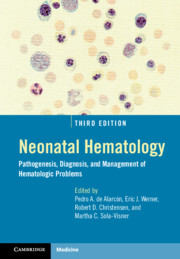Book contents
- Neonatal Hematology
- Neonatal Hematology
- Copyright page
- Contents
- Foreword
- Preface
- Contributors
- Section I Developmental Hematology
- Section II Bone Marrow Failure and Immune Disorders
- Section III Erythrocyte Disorders
- Chapter 6 Newborn Genetic Screening for Blood Disorders
- Chapter 7 A Guide to Identifying the Cause of Anemia in a Neonate
- Chapter 8 Anemia of Prematurity and Indications for Erythropoietin Therapy
- Chapter 9 Hemolytic Disease of the Fetus and Newborn
- Chapter 10 Neonatal Hemolysis
- Chapter 11 Polycythemia and Hyperviscosity in the Newborn
- Section IV Platelet Disorders
- Section V Leucocyte Disorders
- Section VI Hemostatic Disorders
- Section VII Neonatal Transfusion Medicine
- Section VIII Neonatal Oncology
- Section IX Miscellaneous
- Index
- Plate Section (PDF Only)
- References
Chapter 9 - Hemolytic Disease of the Fetus and Newborn
Maternal Antibody Mediated Hemolysis
from Section III - Erythrocyte Disorders
Published online by Cambridge University Press: 30 January 2021
- Neonatal Hematology
- Neonatal Hematology
- Copyright page
- Contents
- Foreword
- Preface
- Contributors
- Section I Developmental Hematology
- Section II Bone Marrow Failure and Immune Disorders
- Section III Erythrocyte Disorders
- Chapter 6 Newborn Genetic Screening for Blood Disorders
- Chapter 7 A Guide to Identifying the Cause of Anemia in a Neonate
- Chapter 8 Anemia of Prematurity and Indications for Erythropoietin Therapy
- Chapter 9 Hemolytic Disease of the Fetus and Newborn
- Chapter 10 Neonatal Hemolysis
- Chapter 11 Polycythemia and Hyperviscosity in the Newborn
- Section IV Platelet Disorders
- Section V Leucocyte Disorders
- Section VI Hemostatic Disorders
- Section VII Neonatal Transfusion Medicine
- Section VIII Neonatal Oncology
- Section IX Miscellaneous
- Index
- Plate Section (PDF Only)
- References
Summary
Hemolytic disease of the fetus and newborn (HDFN) is the immune mediated destruction of fetal and neonatal red blood cells by maternal antibody. HDFN occurs when the fetal red blood cells express a paternally inherited antigen not present on maternal red blood cells. The spectrum of illness ranges from clinically insignificant to that of a critically ill, anemic, hydropic, and jaundiced infant at risk for bilirubin-induced brain damage (kernicterus).
- Type
- Chapter
- Information
- Neonatal HematologyPathogenesis, Diagnosis, and Management of Hematologic Problems, pp. 133 - 154Publisher: Cambridge University PressPrint publication year: 2021
References
- 2
- Cited by



